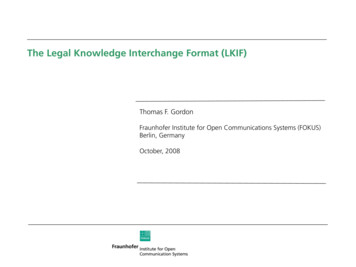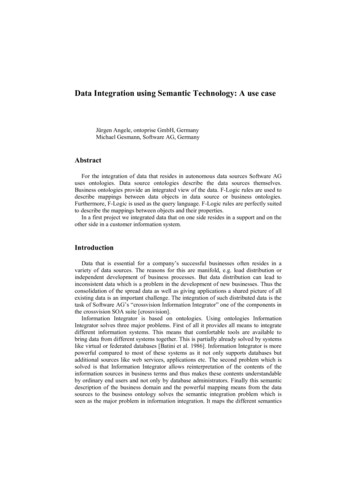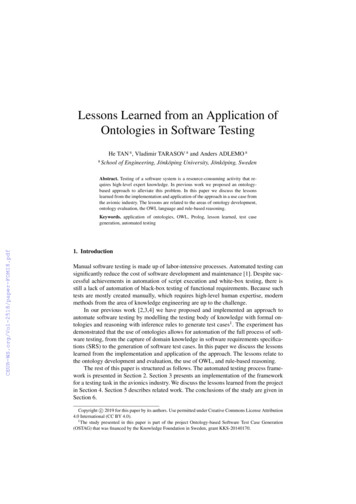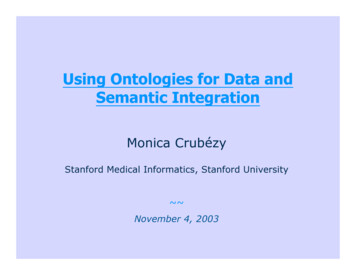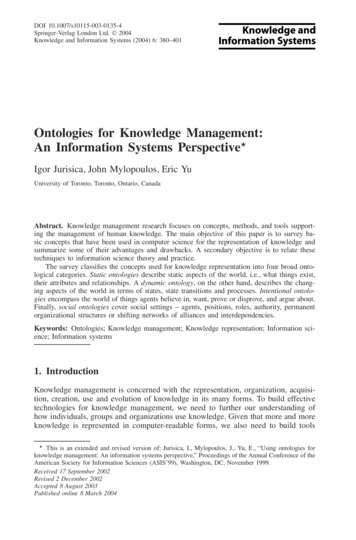
Transcription
DOI 10.1007/s10115-003-0135-4Springer-Verlag London Ltd. 2004Knowledge and Information Systems (2004) 6: 380–401Ontologies for Knowledge Management:An Information Systems Perspective Igor Jurisica, John Mylopoulos, Eric YuUniversity of Toronto, Toronto, Ontario, CanadaAbstract. Knowledge management research focuses on concepts, methods, and tools supporting the management of human knowledge. The main objective of this paper is to survey basic concepts that have been used in computer science for the representation of knowledge andsummarize some of their advantages and drawbacks. A secondary objective is to relate thesetechniques to information science theory and practice.The survey classifies the concepts used for knowledge representation into four broad ontological categories. Static ontologies describe static aspects of the world, i.e., what things exist,their attributes and relationships. A dynamic ontology, on the other hand, describes the changing aspects of the world in terms of states, state transitions and processes. Intentional ontologies encompass the world of things agents believe in, want, prove or disprove, and argue about.Finally, social ontologies cover social settings – agents, positions, roles, authority, permanentorganizational structures or shifting networks of alliances and interdependencies.Keywords: Ontologies; Knowledge management; Knowledge representation; Information science; Information systems1. IntroductionKnowledge management is concerned with the representation, organization, acquisition, creation, use and evolution of knowledge in its many forms. To build effectivetechnologies for knowledge management, we need to further our understanding ofhow individuals, groups and organizations use knowledge. Given that more and moreknowledge is represented in computer-readable forms, we also need to build tools This is an extended and revised version of: Jurisica, I., Mylopoulos, J., Yu, E., “Using ontologies forknowledge management: An information systems perspective,” Proceedings of the Annual Conference of theAmerican Society for Information Sciences (ASIS’99), Washington, DC, November 1999.Received 17 September 2002Revised 2 December 2002Accepted 8 August 2003Published online 8 March 2004
Ontologies for Knowledge Management: An Information Systems Perspective381that can effectively search databases, files, web sites and the like to extract information, capture its meaning, organize and analyze it, and make it useful. This paperfocuses on the concepts used in computer-based information systems to capture andexploit the meaning of information.Information science, as it exists today, already provides many of the foundationsfor knowledge management. After all, the documentation tradition has a long history of developing methods and practices for organizing the vast expanses of humanknowledge so that it is accessible by diverse users. The computational side of information science has developed powerful techniques for retrieving documents throughdifferent forms of computer-based processing and search (Buckland 1999). Information science has also been building on the technologies of information systems tomanage the vast amounts of information – initially for catalogues and bibliographicinformation, then for full-text documents, and most recently for distributed, heterogeneous information sources. Nevertheless, many significant challenges remain.Historically, information science has focused on the document as the primary unitof information. Documents have traditionally been paper based, consisting primarilyof published books and articles. The contents of such documents have been individually meaningful, at least at a literal, surface level. Deeper meanings, however, dorequire interpretation in relation to interconnected documents as well as social andcultural contexts. These connections are usually relatively sparse (e.g., a few dozenreferences in an academic article) and have little built-in semantics. For instance,a reference simply leads to another document, much like untyped hypertext linksthat dominate today’s World Wide Web (WWW). Moreover, documents have traditionally been fairly stable, and new ones took considerable time and effort to create.Finally, documents were primarily used by humans, who read, interpreted and actedon them.The digital media have changed all that. Documents can now be arbitrarily large,as they can be composites of volumes or even libraries of material. More importantly,they can be arbitrarily small – paragraphs, text fragments, pieces of data, video oraudio clips, etc. They are documents not so much in the common sense usage ofthe term, but rather logically identifiable and locatable packages of information. Thischange in the granularity of information units has increased the number of units thatneed to be managed by many orders of magnitude. In addition, today’s documentstend to be much more densely connected, referring or relating to each other in multiple ways. Moreover, documents are continuously created and revised, post-it notesare attached, detached, reattached in a different context, or discarded. Documentscan even be active, with embedded software code (e.g., applets and software agents)that exhibit dynamic or even self-activating behavior. Today’s knowledge work reliesheavily on digital media. This means that research on knowledge management mustdeal with this new, much more demanding notion of a document.In contrast, the field of information systems has historically started off fromthe other end of the information unit spectrum. Information in information systemscomes in small chunks – e.g., bank account balances, ticket reservations, etc. Suchinformation can change quickly and frequently, so the management of dynamic information has always been fundamental to information systems. Information itemsusually need to be interpreted in relation to other items, e.g., London by itself ona ticket is quite meaningless unless you know that it is a departure or destination city,on what date, what airline, for which passenger, etc. These relationships need to beformally defined so that the network of connected information can be navigated andoperated on by automated procedures in order to produce a ticket within seconds.Now that fast and reliable information processing has become commonplace, people
382I. Jurisica et al.have come to expect equally powerful technologies for managing much more complex knowledge structures. As in the case of information science, some foundationshave been laid in information systems for managing knowledge, but there are considerable challenges too. Perhaps the most important among these is the developmentof techniques for exploiting meaning to produce computationally useful results.Section 2 of the paper discusses basic approaches to capture the meaning ofinformation, while Sect. 3 introduces ontologies and discusses four categories ofontological elements. In Sect. 4, we discuss applications of ontologies in medicine.Section 5 includes discussion and summarization of the main points of the paper.2. Exploiting Meaning in Information SystemsInterestingly, within the field of computer science, there has been a gradual movement toward what one might call knowledge orientation or semantic processing. Thishas been taking place over the past 20–30 years, long before the term or conceptof knowledge management became fashionable. Although there is no consensus ona notion of knowledge or knowledge-based processing in computer science, the termsare used usually in contradistinction with data or data processing to highlight theneed to clarify the relationship between symbols stored in computers and what theyrepresent in the world outside. The terms also imply technologies that deal explicitlyand formally with the semantics of such representations and their manipulations.An assortment of techniques for representing and managing codified knowledgehas emerged from several areas in computer science, notably artificial intelligence,databases, software engineering, and information systems. This movement towardknowledge orientation has not been organized into a coherent research methodology,as it has come about for a variety of reasons. From a practical standpoint, the growing complexity of application domains and the increasing intertwining of machineand human processes have all contributed to the recognition of knowledge orientation as a promising research direction that can address open knowledge-managementproblems. However, the movement has also been motivated by the search for solidfoundations in various computing disciplines (Bubenko 1980; Newell 1982; Ullman1988).Artificial Intelligence has developed techniques for representing knowledge informs that can be exploited by computational procedures and heuristics. Research ondatabases has produced techniques that support the representation and managementof large amounts of relatively simple information. Supporting mechanisms includerelational databases and associated technologies. Software engineering has developedelaborate techniques for capturing knowledge that relates to the requirements, designdecisions and rationale for a software system. The area of information systems hasbenefited directly or indirectly from these developments.In computer-based information systems, the meaning of information is usuallycaptured in terms of conceptual information models that offer semantic terms formodeling applications and structuring information (Mylopoulos 1998). These modelsbuild on primitive concepts such as entity, activity, agent and goal. In addition, themodels support mechanisms for organizing information along generic abstraction dimensions, such as generalization, aggregation and classification (Mylopoulos et al.1998). Defining terms and mechanisms for information modeling and organizationin conceptual models requires assumptions about the applications to be modeled.For example, if we assume that our applications will consist of interrelated entities,it makes sense to build terms such as entity and relationship into our conceptual
Ontologies for Knowledge Management: An Information Systems Perspective383model, and to allow computation based on the semantics of those terms, i.e., tosupport navigation, search, retrieval, update and inference that are consistent withthe meaning of those terms. The identification of the right concepts for modelinga world for which one would like to do computations (or knowledge managementoperations) has come to be known as an ontology within computer science.3. OntologiesOntology is a branch of philosophy concerned with the study of what exists. Formalontologies have been proposed since the 18th century, including recent ones suchas those by Carnap (1967) and Bunge (1977). In computer science, ontologies havecome in a variety of forms, ranging from lexicons, to dictionaries and thesauri oreven first order logical theories. Lexicons provide a standardized dictionary of termsfor use during, for example, indexing or retrieval. Dictionaries can be organizedaccording to specific relations to form hierarchies (taxonomies, meronomies, etc.).Thesauri add related terms to any given term. In any of these forms, ontologiesare useful because they encourage standardization of the terms used to representknowledge about a domain. When ontologies are formalized in first-order logic ora subset thereof, they can also support inference mechanisms. For a given collectionof facts, these mechanisms can be used to derive new facts or check for consistency.Such computational aids are clearly useful for knowledge management, especiallywhen one is dealing with large amounts of knowledge.For example, if one is interested in health care-related knowledge, then patient,disease, symptom, diagnosis, and treatment might be among the primitive conceptsupon which one might want to describe the application domain. These conceptsand their meanings together define an ontology for health care. Such an ontologycan be used as common knowledge that facilitates communication among healthworkers. It can also be used during development of hospital information systemsor decision-support systems. Similarly, an ontology for manufacturing may includethe concepts of (industrial) process, resource, schedule, product and the like (Vernadat 1996). Brazma et al. (2001) proposes a flexible and open specification languagecalled MIAME (Minimum Information About Microarray Experiments) to representmicroarray experiments. Although details for particular experiments may be different,MIAME aims to define the core that is common to most experiments. MIAME isnot a formal specification language, but a set of guidelines, which encourages usersto provide their own qualifiers and values identifying the source of their terminology.It promotes the use of controlled vocabularies and external ontologies.Early work in computational ontologies includes the Cyc project (Lenat and Guha1990) and the ARPA knowledge sharing effort (Neches et al. 1991). The knowledgeinterchange format effort provides a declarative language for describing knowledge(Genesereth 1991). Research within artificial intelligence has formalized interestingspecialized ontologies and has developed techniques for using them to represent andanalyze knowledge. Well-designed ontologies need to be addressed as properly deepand long-standing problems in philosophy, such as the problems of identity and unity.The designer of ontologies needs to provide answers to questions such as: Do entities have any essential properties? Does a change of parts affect identity? When does an entity count as one?Guarino and Welty (2000) offer an elegant account of how such issues can betaken into consideration in the design of taxonomies of concepts. Along a very differ-
384I. Jurisica et al.ent path, Wand (1989, 1990) studied the adequacy of conceptual models to describeapplications based on a general ontology, such as that proposed by Bunge (1977).To characterize and classify current work on ontologies, we propose four broadontological categories, which, respectively, deal with static, dynamic, intentional andsocial aspects of the world. Our claim is that, for a large class of applications, therepresentation of relevant knowledge can be based on primitive concepts derivedfrom these four ontological categories. For example, if we want to model a university environment, we may choose entities and relations to model static aspects ofthe domain and processes to model dynamic aspects. For a multiagent system, onthe other hand, we may want to use concepts such as agent, team, goal and socialdependency to model social and intentional aspects of the application. Of course,agents and goals could be represented simply as entities. Such representations, however, miss important properties of agency (e.g., an agent’s intentionality and autonomy) and lead to incomplete forms of inference. For example, representations thatuse elements of dynamic ontologies are amenable to simulation, a special form ofinference not supported by static ontologies. Likewise, formal goal models supporttheir own special forms of reasoning – e.g., Giorgini et al. (2002) – that go beyondinference mechanisms for entities and relationships. Our classification of ontological concepts into four categories has been derived from a broad survey of modelingtechniques in computer science (Mylopoulos 1998).The rest of the section briefly reviews the four categories. A static ontology describes things that exist, their attributes and relationships. A dynamic ontology describes the world in terms of states, state transitions and processes. An intentionalontology encompasses the world of agents, things agents believe in, want, prove ordisprove, and argue about. Finally, a social ontology covers social settings, permanentorganizational structures or shifting networks of alliances and interdependencies.3.1. Static OntologiesA static ontology describes static aspects of the world, i.e., what things exist, theirattributes and relationships. Most knowledge representation frameworks assume thatthe world is populated by entities that are endowed with a unique and immutableidentity, a lifetime, a set of attributes, and relationships to other entities. Basic as thisontology may seem, it is by no means universal. For instance, Hayes (1985) offers anontology for different classes of applications modeling of material substances whereentities (say, a liter of water and a pound of sugar) can be merged resulting ina different entity. Also note that some successful models, such as statecharts (Harel1987), do not support elements from a static ontology because they are intended forreal-time systems. Static ontologies are not trivial. For certain applications, it is usefulto distinguish between different modes of existence for entities, including physicalexistence, such as that of the authors of this paper, abstract existence, such as thatof the number 7, nonexistence, characteristics of Santa Claus or John’s canceled tripto Japan, and impossible existence, such as that of the square root of 1 or theproverbial square circle (Hirst 1989).As an example, a partial static ontology for a hospital expressed in the KAOSmodeling language (Dardenne et al. 1993) is presented in Fig. 1. According to theexample, an entity hospital is defined with associated attributes admitted, released,registered, available and specialty. The first three attributes take as values sets of instances of patient, available takes as values sets of instances of doctor, and specialtytakes as values sets of instances of subject. The definition includes one set-theoretic
Ontologies for Knowledge Management: An Information Systems Perspective385Fig. 1. An example of a partial static ontology for a hospital in KAOS modeling language (Dardenne et al.1993).invariant constraint, which states that admitted is a subset of registered for everyinstance hosp of hospital. In addition, admitted and released are mutually exclusivesets at one instance of time. Next we define the relationship class treating, whichrelates a patient to a hospital entity, has associated cardinality constraints and an invariant. The invariant states that if a patient is treated in the hospital and the patientis in the hospital, then the patient is eventually released.Many domains require support for description and analysis of image data. Forexample, an ontology for an in vitro fertilization (IVF) clinic needs concepts forpatient, diagnosis, treatment and morphological characteristics of sperms, oocytesand embryos (Jurisica et al. 1998).Spatial information is also important for applications that involve the physicalworld, such as geographic information systems, e.g., Croner et al. (1996). Spatial information has been modeled in terms of two-dimensional (2D) and three-dimension(3D) points or larger units, such as spheres, cubes or pyramids. Formal spatial ontologies enable computational and reasoning operations such as rotation and occlusion tobe provided. One such class of applications deals with representing 2D and 3D formations of proteins. Proteins are large, complex molecules composed of long chainsof molecules, called amino acids. They provide the structural components of cells andenzymes for essential biochemical reactions. The subcellular localization of proteinsspecifies where they are and determines their ability to interact with other proteinsand small metabolites in their local environment. One can then define an ontologyfor biological function using molecular interactions (Karp 2000), which then enablescomputation with biological function. Subcellular localization of proteins is anotherkey functional characteristic. Gene ontology addresses this issue at the cellular levelby providing a hierarchy of cellular component concepts such as organelles, membranes and protein complexes (Ashburner et al. 2000). These concepts are used toannotate the location of gene products (Xie et al. 2002).3.2. Dynamic OntologiesDynamic ontologies describe changing aspects of the world. Typical primitive concepts include state, state transition and process. Various flavors of finite-state ma-
386I. Jurisica et al.Fig. 2. ConGolog (Levesque et al. 1997) specification of the process of IVF action after successful oocytefertilization. The physician has to, in Parallel, consider patient’s characteristics and morphological propertiesof embryos.chines and Petri nets have been offered since the 1960s as appropriate modelingtools for dynamic discrete processes. Such models are well understood and have beenused extensively to describe real-time applications in telecommunications and otherfields. Statecharts constitute a more recent proposal for specifying large, finite-statemachines (Harel 1987). A statechart is also defined in terms of states and transitions,but more than one state may be on at any one time, and states can be defined asAND or OR compositions of other statecharts. As a result, statecharts have beenproven much more effective in defining and simulating large, finite-state machinescompared with conventional modeling methods. The statecharts model is supportedby a popular CASE tool called Statemate.To take another example from the reproductive-medicine domain, an IVF procedure consists of patient selection by diagnosis of infertility, controlled ovarian stimulation for multiple oocyte recruitment and maturation, close monitoring of folliculardevelopment by ultrasound and hormonal assessment, oocyte retrieval, inseminationof oocytes in vitro, determination of fertilization, assessment of embryo development and quality, assessment of endometrial quality, and intrauterine transfer of oneor more cleaved embryos (Jurisica et al. 1998). During the treatment, decisions ata particular state depend on results of previous states. To describe such a process, wecould use the ConGolog language (Levesque et al. 1997). ConGolog is a high-levelspecification language for defining concurrent processes. Primitive actions can be defined in terms of pre- and postconditions. Primitive actions can be composed intoprocedures using modeling constructs such as sequencing (‘;’), conditional (if-then),iteration (while condition do), concurrent activity (‘ ’), nondeterministic choice(choose), etc. Although ConGolog offers programming language-like structures fordescribing processes, its distinctive feature is that the underlying logic is designed tosupport reasoning with respect to process specifications and simulations, even whenthe initial state for the process is only partially specified.Figure 2 shows how one could use ConGolog to define a process for determiningIVF action after successful oocyte fertilization. During the process, the physician hasto consider the patient’s characteristics (her response to hormonal therapy, treatmenthistory, age, etc.) and morphological properties of embryos. These two actions are
Ontologies for Knowledge Management: An Information Systems Perspective387to be carried out in parallel. Because the quality of individual embryos varies, onehas to consider them iteratively to decide on the action.Temporal information is often needed when describing dynamic worlds. A temporal ontology can be based on time points and associated relations. An event can berepresented as a single time point or multiple time points. Relations such as beforeor after can be used to relate individual points. Allen (1984) proposes a differentontology for time based on intervals, with 13 associated relations such as overlap,meet, before and after.Causality is a concept that is closely related to time. Causality imposes existenceconstraints on events: if event A causes event B and A has been observed, B can beexpected as well, possibly with some time delay. For example, if a patient has anoocyte of lower quality, it is expected that it will develop into an embryo of a lowerquality. In this context, one may need to explore properties such as probability andtransitivity.3.3. Intentional OntologiesIntentional ontologies encompass the world of motivations, intents, goals, beliefs,alternatives, choices, etc. Typical primitive concepts include issue, goal, supports,denies, subgoalOf, agent, etc. An intentional ontology enables alternate realities tobe expressed and reasoned about. The subject of agents having beliefs and goalsand being capable of carrying out actions has been studied extensively. For example,Maida (1982) addresses the problem of representing propositional attitudes, such asbeliefs, desires and intentions for agents.Modeling the issues that arise during complex decision making is discussed inConklin and Begeman (1988). The application of such a framework to software design, intended to capture the arguments pro and con, and the decisions they resultin, has been a fruitful research direction since it was first proposed in Potts andBruns (1988), with notable refinements described in MacLean et al. (1991), Lee andLai (1991). For example, MacLean et al. (1991) models design rationale in terms ofquestions (Q), options (O) and criteria (C). Figure 3 shows the structure of a decision space concerning the design of an automated teller machine (ATM). The fourquestions raised have associated options. Choice among them will be done by usingan associated list of criteria. For example, for the question of what range of serviceswill be offered (by the ATM under design), there are two options, full range andcash only, and two criteria for choosing among them. The cash-only option raisesan auxiliary question, whether services can be restricted by having switchable machines, where services can be masked out, or by having machines that are inherentlylimited in the services they offer. On a complementary front, Gotel and Finkelstein(1995) study the types of contributions a stakeholder can make to an argumentationstructure such as the one shown in Fig. 3.The importance of the notion of goals and agents, especially for situations involving concurrent actions, has a long tradition in requirements modeling, beginningwith Feather (1987) and continuing with influential proposals, such as Dardenne etal. (1993) and Chung (1993).Software nonfunctional requirements (NFRs), such as software usability, security, reliability, user friendliness, performance, etc., can be modeled using softgoals(Chung 1993; Mylopoulos et al. 1999). Softgoals are goals whose criteria for satisfaction are not crisply defined a priori. The softgoal concept extends intentionalontologies for capturing design rationale (Potts and Bruns 1988). Making available
388I. Jurisica et al.Fig. 3. Modeling design rationale in terms of questions (Q), options (O) and criteria (C).intentional information such as pro and con arguments and resulting decisions canbe very useful during design and maintenance of information systems. It has beenshown that softgoals can play an important role in many design tasks by guiding thedesigner through alternative design choices. Jurisica and Nixon (1998) show how onewould use softgoals to build quality into complex medical decision-support systems.Consider an example of an information system for an IVF clinic, with the aim tofulfill both clinical and research purposes. Suppose potential users rate performanceas an important factor for the system. Further assume that good performance is characterized as fast response time when accessing patient records, for reasoning as wellas patient record updates. This requirement is represented as a softgoal: Time[PatientRecords and Reasoning], as shown at the top of Fig. 4. Time is the type of the softgoal and [Patient Records and Reasoning] is the topic. This goal may be synergisticor competing with other goals, such as Time[Research Reasoning], which requiresfast response time for inference operations done by researchers. Using methods andcatalogues of knowledge (for performance, case-based reasoning, IVF, etc.), goalscan be refined into more specialized goals. Here the developer uses knowledge ofthe IVF domain to refine the time goal for patient information into two subgoals,one for good response time for updating patient records and the other for good response time for the retrieval and decision-making process. These two subgoals areconnected by an And relationship to the parent goal. This means that if both subgoals are satisficed, then the parent goal is satisficed as well. Because, by nature,softgoals are not formalizable, we say that they are satisficed rather than satisfied.Satisficing implies good enough rather than complete solutions to a given problem.The figure also shows an example of recording design rationale – the reasonsbehind design decisions – using NFR framework claims (Chung et al. 2000). Aspart of the development graph, recorded claims are available when making furtherdecisions and changes. It is important to note that the developers use their expertiseto determine what to refine, how to refine it, to what extent to refine it, as well aswhen to refine it. The NFR framework and its associated tool can help the developer
Ontologies for Knowledge Management: An Information Systems Perspective389Fig. 4. Representing performance requirements for an IVF decision-support system using softgoals from theNFR framework (Chung et al. 2000). Nonfunctional requirements (initially represented as NFR softgoals) arerefined until implementable solutions are identified (represented as operationalizing softgoals). Subgoals maycontribute positively or negatively, to different extents, toward higher goals – MAKE means sufficiently positive, BREAK means sufficiently negative, HELP and HURT denote partial contributions. The contributiontypes are used to propagate the evaluation of solution alternatives toward the higher goals.do consistency checking and keep track of decisions, but it is the developer whocontrols t
ment toward what one might call knowledge orientation or semantic processing. This has been taking place over the past 20-30 years, long before the term or concept of knowledge management became fashionable. Although there is no consensus on a notion of knowledge or knowledge-based processing in computer science, the terms
